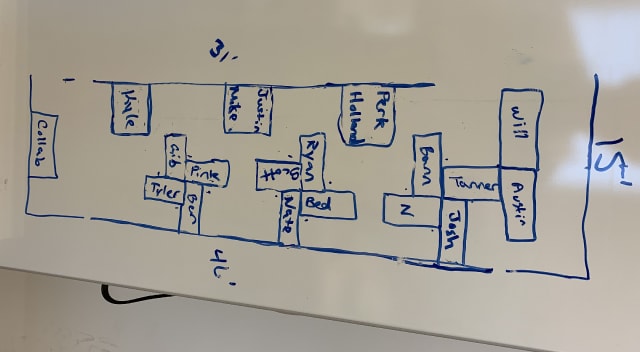Back Story
Our team embraces a highly collaborative work environment with an open office layout. No employee has their own personal office, instead we have ample meeting space for client, personal or private meeting needs.
Each team is comprised of anywhere from 8-20 people, with approximately 5 distinct teams operating throughout the company. As team size began to grow over the years, we experienced issues with continuous collaboration as well as appropriately using physical space to its maximum potential. When new team members were hired, they were placed at the ends of a row and tables began to wrap around the office. Additionally, power cords and surge protectors were daisy-chained together to allow for all the necessary AC power - not good!
This photo is of a simple 6 person configuration. Imagine this repeated 4x in a row.
Initial Research
We researched a variety of solutions that could solve our challenges with space:
- Radically change the traditional desk arrangement
- Rent additional office space (lease the space underneath our current workspace)
- Minimize individual desk-space to accomodate more people in a tighter space
- Reduce open collaboration spaces and begin to occupy them with new desks
Each solution seemed to have more drawbacks than the previous. Why did we need to sacrifice the work environment to accommodate more people? Or rather, why did we need to increase our expenses to add a few additional employees? Or team isn’t at a size that warrants that much office space currently.
Our team re-grouped and prioritized what mattered to us in our working space.
Collaboration
We are a group of engineers and designers, working together and having continuous communication is vital. Tools like Slack work great as a crutch in work environments, but cannot replace the synergy of working in-person through challenges.
Privacy
There are times you just need to put your head down and work. Noise, foot traffic, etc. can all impact how focused you are in your work. Our team valued the ability to plug-in to their niche and quickly come together to collaborate.
Team Radius
As teams grow, distinct functions of that team begin to form. We originally were a team of full-stack engineers and realized that dedicated front-end/back-end teams was more profitable and produced more throughput. When that team grows, it’s valuable to keep those working together the most, to be within conversational reach. We valued having our operating team as close as we can without having to use meeting space.
Feels Homie
With spending so much time in an office, it starts to become an extension of yourself. You want an environment that is both comfortable and safe. We wanted an environment where you aren’t facing a wall, instead you are looking at your peers. We also valued our open office layout and did not want additional walls/silos in our team.
Our Approach
After a depth of research into different desk configurations that could meet each of these goals, we eventually settled on a variation of the pin-wheel desk configuration. Due to space constraints, we couldn’t accomplish a full spread pin-wheel desk configuration in 15’ wide and 46’ long hallway. Before moving any desks, we planned out our attack (as engineers do!).
We aligned team members that needed to collaborate the most and created spaces that accomplished both privacy, homie (natural light/window views) and placed teams within a convenient radius.
The Results
We made this change on July 10th. Since then we have had an increase in collaboration, productivity and improved cross-team communication. Team members have been able to improve their relationships with team members they did not have social collaboration with in the past. We have also increased the maximum physical capacity by 4 desk set-ups.
The team has a whole as unanimously agreed this desk configuration is an improvement over the traditional line arrangement.
What's Next?
Cable management is our next priority to improve the organization and safety of our working space.






Top comments (0)